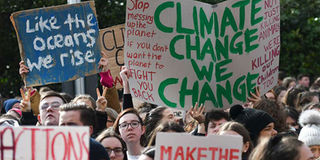To beat effects of climate change, let us try new farming practices

Thousands of Irish students participate in the “Global School Strike for Climate Action” march from St Stephen's Green to Leinster House, demanding an immediate action on climate change, on March 15, 2019 in Dublin, Ireland. The future remains bleak if the issue is not resolved. PHOTO | ARTUR WIDAK | NATION MEDIA GROUP
What you need to know:
- The most urgent measure we in Kenya must take is to ensure food self-sufficiency by coming up with ideas that are not only home-grown but practical.
- Those who have been attending newly reintroduced field extension sessions are full of praise for the practical education they are receiving.
I spent the better part of this week waiting for rain back in my Gatundu village.
Three days is a long time to wait for raindrops which wouldn’t co-operate despite the fervent prayers of many a hapless rain-farmer who hopes his seedlings will not shrivel and die as they have invariably done in the past three seasons.
In the end, I had no choice but to head back to “civilisation” where very little grows except the stuff sold in urban areas by canny “farmers” who have appropriated land close to sewerage plants for the purpose.
As matters stand now, the seedbeds I had prepared for vegetables and melons are still bare, and this time I can’t even blame the weatherman for getting it wrong on the intensity of the precipitation to be expected; we were told the long rains would not be adequate.
But people have become quite sceptical about weather forecasts.
DROUGHT
Indeed, a wag jokes that if someone at the Met tells you it will rain, then wear a very light jacket, but if she says it will be hot and sunny, then be sure to carry an umbrella.
Jokes aside, perhaps the reason why predicting the weather with any kind of precision these days has become difficult is that the patterns have gone crazy.
No longer does it rain when expected, and the dry spells are becoming longer and more devastating with each passing year.
The problem is that droughts are now more persistent, not just in the counties usually described as the usual suspects, but in many others that used to produce enough grain, legumes and tubers for subsistence.
Although rejecting the evidence of our eyes has become the trend in some parts of the world, the reason is quite simple — climate change.
GLOBAL WARMING
I’ve failed to understand why some important global leaders have consistently denied there is anything like climate change and that the world is facing irreparable ecological ruin due to human activities.
Global warming, the deniers insist, is an old wives’ tale concocted to scare away industrialists and impoverish investors in fossil fuel production.
To the rest of the world, such deductions are completely myopic.
Since such people can’t explain why glaciers in the cold lands are melting at an accelerated rate while the oceans are filling up and threatening to swallow shallow islands, and since they can’t say why rain patterns are changing and heavy floods keep alternating with long droughts, they’ve resorted to arguing that proof of climate change is “fake science”.
The problem is that the major destroyers of the ozone layer through greenhouse gases like carbon dioxide, methane and chlorofluorocarbons are the same ones denying that a global calamity looms.
SOLUTIONS
In fact, climate change is real and we in the less-developed world, especially in Africa, which produces insignificant greenhouse gases, are the main victims of this global phenomenon “imported” from the industrialised Europe, the Americas and Asia.
We all must do whatever little we can to ameliorate global warming as there’s no time to waste.
That’s why we have repeatedly been warned against depleting our forests, but some people counter such sensible suggestions by arguing that trees never brought rain.
Kenya is one of the most food-insecure countries in the world — because once upon a time our ravenous compatriots felled trees as though there was no tomorrow.
Moreover, we still don’t have the wherewithal to mitigate the ill-effects of climate change.
The most urgent measure we in Kenya must take is to ensure food self-sufficiency by coming up with ideas that are not only home-grown but practical, and it is comforting to learn that someone has been thinking hard on the matter.
IRRIGATION
According to a report released early this week, the government intends to dabble in some form of collectivisation targeting one million farmers and pastoralists in 40 zones, assist 50 large-scale farms owned by individuals, set up agro-processing hubs for value addition, boost irrigation which is extremely low, and even shift to genetically modified food production.
If all these measures work, then there is a likelihood that the agriculture sector will recover sufficiently.
But this is a big IF. So far, we have not done very well in this sector because large-scale projects like Galana Kulalu and at least two proposed mega dams have been gnawed to the bone by rent-seekers.
However, some of the proposed measures are already under trial in select zones and they seem to be working.
EDUCATION
Those who have been attending newly reintroduced field extension sessions are full of praise for the practical education they are receiving.
In the meantime, a consensus is emerging that too much red meat is bad for you and also contributes heavily to global warming.
According to experts, that cow pat may be good for manure, but it produces high volumes of greenhouse gases.
Somehow, I don’t think that view will resonate very well with many Kenyans who value their nyama choma weekends, but they can never say they weren’t warned.
Mr Ngwiri is a consultant editor; [email protected]





